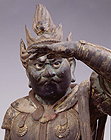Japanese Gallery (Honkan) Room 14
July 12, 2011 (Tue) - October 2, 2011 (Sun)
The two Dainichi Nyorai (Sk: Mahavairocana) statues exhibited here share many similarities in style and structure, as well as in the types of dedicatory objects contained within the statues and the manner of their installation. Both statues are thought to be the works of the Kamakura-period Buddhist sculptor, Unkei. The plinth of the Kotokuji temple statue (adorned with four lions) and the halo were all produced around the same time as the statue itself, as was the shrine and the 37 Buddha figures riding on clouds within. It is likely that the Shinnyoen temple statue was also originally furnished with similar ornamentation. While both statues are small, the hair, posture, body curves and folds of the clothing all appear splendidly realistic from any angle, whether front, side or back. These works demonstrate the expertise of Unkei, one of the greatest sculptors in the history of Japanese art.
Unkei was one of the leaders of the Kei school of Buddhist sculptors, a group so called because many members used the word “kei” in their names. In the Kamakura period, this school pioneered a bold, realistic style that took the world of Buddhist sculpture by storm. This exhibition also displays several statues of the Twelve Heavenly Generals from Sogenji temple, Kanagawa prefecture and Tokyo National Museum. Though the Museum’s statues are more gorgeous and refined, the sense of power and movement in both sets of statues is worthy of note. We also invite you to observe how the jocular expressions of Sogenji’s Rat General and the Museum’s Monkey General have been inherited by the attendant of Zochoten, the Guardian of the South (Sk: Virudhaka, one of the Four Heavenly Kings), a statue sculpted by Unkei’s grandson, Koen.

